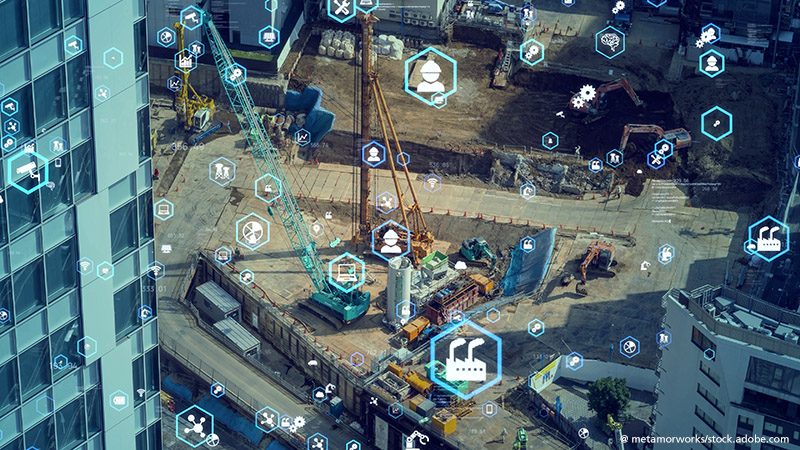5G networks under harsh conditions: Real-time information exchange from machines to automate work in construction and mining and make it safer
Since the end of 2019, the Fraunhofer Institute for Production Technology IPT in Aachen has been making research in industrial applications of 5G mobile communication technology – and now the findings from previous research projects are to be transferred to the construction and mining sectors. The aim of a consortium of research institutions and industrial companies in the "5G.NAMICO - Networked, Adaptive Mining and Construction" project is to drive digitization in construction and mining, as well as to increase the efficiency of work processes and relieve personnel of monotonous and dangerous work. To test the possibilities of the technology, our partners are using two newly established 5G networks: one at a reference construction site in Aachen and one in an underground mine in Sondershausen, Thuringia.

5G offers new opportunities for construction and mining: Work processes can be made more efficient, productive, and safe with partially or fully autonomous machines and robots, and construction machinery can be digitally monitored and controlled remotely.
Remote control of construction machinery can then be optimized, for example, by using a virtual three-dimensional image of the working environment, so that remote-controlled construction machinery can be used more efficiently and safely.
The use of partially or fully autonomous or remote-controlled machines in the construction and mining industries requires high-performance communication networks that are suitable for the typical harsh and ever-changing operating conditions. In the 5G.NAMICO project, various network configurations are being investigated, and performance measurements are being carried out. In underground mines, which often have a widely ramified routing, continuous positioning of personnel and machines is particularly difficult because GPS is not available here. 5G network technology can not only enable data transfer in underground mines, but also provides the potential for real-time positioning. In this way, the technology can help prevent workplace accidents based on missing or incorrect information from a communication participant. In case of severe, accidents, victims can also be located and rescued more quickly due to improved communication.
5G can make construction and mining safer, more efficient and more sustainable
While the use of the technology first was primarily tested in "clean" industrial production environments and open areas, harsh and ever-changing environments are found in construction and mining: Dust, vibrations and humidity affect the dynamic 5G network. To ensure that the communication and networking of construction machinery and mining equipment can function smoothly, the technology must be tested and further developed under real operating conditions. For example, the environment in the effective range of the machines must be thoroughly recorded so that the risk to people in the immediate vicinity can be ruled out. This requires a stable and wireless form of data transmission that can transfer the signals between the individual machines as well as people with low latencies. For example, researchers are investigating the use of slotted cables as an alternative to antennas. These cables have small slots through which signals can be sent and received and can be laid flexibly on the construction site and in the mine.
Jointly testing 5G in the construction and mining sector
Together with the Chairs of Sustainable Resource Recovery (MRE) and of Individualized Construction Production (IP) at RWTH Aachen University and the industrial partners Construction Robotics and Nerospec SK, the Fraunhofer IPT will conduct research in the 5G. NAMICO over the next two years to determine the requirements and conduct technical planning of the two 5G networks in the construction and mining industries. The networking and communications company Ericsson is involved in the project as a mobile network supplier. In addition, Kabelwerk Eupen AG is participating in the network rollout. Together, the partners are investigating both the overall digital infrastructure and the architecture of the 5G networks and defining the required technologies such as transmission and reception components. Based on this, the planned networks are installed and subsequently the network parameters are optimized to implement the identified requirements. In a final step, the partners test the designed and installed 5G networks for their suitability using real use cases in the mine and on the construction site. Therefore, they are investigating a semi-autonomous and remote-controlled mining and dismantling operation.
The Fraunhofer IPT is assuming consortium leadership in the 5G.NAMICO project and is contributing the expertise it has gained in recent years on the industrial use of 5G. The Fraunhofer IPT has been investigating the use of 5G in industrial production since 2017. During the research work, the scientists from Aachen, together with mobile communications equipment supplier Ericsson, installed and commissioned the "5G-Industry Campus Europe" one of the world's first 5G research networks on the Melaten campus of RWTH Aachen University. On just under one square kilometers of outdoor and indoor network, the partners have since been researching the requirements for a 5G network in a production context and associated use cases in the areas of sensor technology, robotics, logistics and cross-site production chains. The extension of the application of 5G to underground mining and construction thus forms a seamless evolution of previous research activities.
The "5G.NAMICO" project is funded by the state of North Rhine-Westphalia through the Ministry of Economic Affairs, Innovation, Digitalization and Energy with the funding code 005-2108-0111. The first tests with the 5G network underground in the Sondershausen mine are planned from the beginning of 2023, while the 5G network on site will be put into operation in the second half of the year.
Project consortium
- Fraunhofer Institute for Production Technology IPT, Aachen
- Chair for Individualized Construction Production IP at RWTH Aachen University
- Chair for Sustainable Resource Recovery MRE at RWTH Aachen University
- Construction Robotics GmbH, Aachen
- Nerospec SK GmbH, Velbert-Langenberg
Associated partners
- Kabelwerk Eupen AG, Eupen, Belgium
- Ericsson GmbH, Herzogenrath
- GHH Fahrzeuge GmbH, Gelsenkirchen
- BAT Mining Service GmbH, Merkers-Kieselbach
- BROKK DA GmbH, Friedenweiler
- Liebherr-Werk Biberach GmbH
- PORR AG, Vienna, Austria